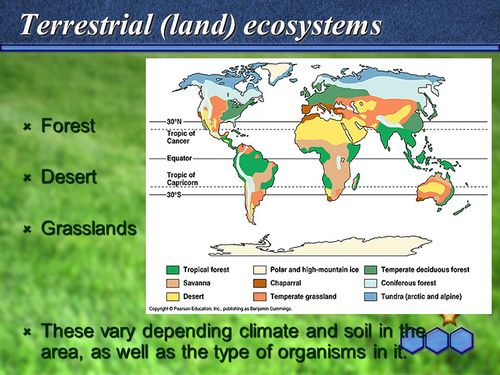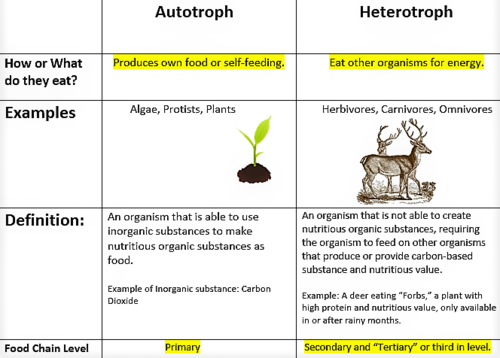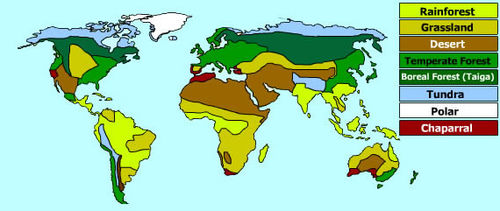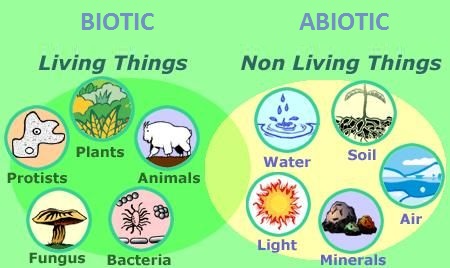Terrestrial ecology
Terrestrial Ecology specifies the relations of organisms and their physical environment on land. Terrestrial Ecology can be further defined through categorization of terrestrial biomes and terrestrial ecosystems.
Terrestrial Ecosystems vs Terrestrial Biomes
Terrestrial ecosystems can be defined as a community of interaction between many living organisms and nonliving things on land. Terrestrial Biomes can be defined as an area, on land, that can be classified by the animals and plants that live within it. In some cases, there can be a few different ecosystems within a terrestrial biome. This means that biomes are on a larger geographical scale than ecosystems.
Terrestrial Biomes
Environments can be classified and categorized into several communities and these are called Biomes. Biomes, defined by Biology-online.org, are major ecological communities of organisms adapted to a particular climatic or environmental condition on a large geographic area in which they occur. There are several terrestrial biomes to consider when studying this topic: Tundra, Taiga, Polar, Savanna, Grassland, Chaparral, Desert, Tropical, and Temperate deciduous forest.

Tundra: Low temperatures and short growing season, which makes for a less productive ecosystem.
Grassland: Hot summers and cold winters, precipitation plays a vital role in the productivity within this biome.
Desert: Great variability due to the different types of deserts. Low precipitation and productivity solely depends upon the type of desert.
Savanna: Long dry seasons and low amounts of rainfall. Typically are productive due to adaptations of communities. (Ex: Serengeti Plain in Africa)
Tropical: Warm and lots of rainfall. High productivity due to ideal climate conditions and rich soil.
Taiga: Commonly known as Coniferous forests. Long, cold winters and short, cool summers. Productivity is dependent on the season.
Chaparral: Wet winters and dry summers. Low productivity due to long dry summers and low quality in soil. (ex: Mediterranean climate)
Temperate Deciduous Forest: Cool winters and warm summers. Year round precipitation makes for a high productivity.
Polar: Extremely cold temperatures, so cold, the climate averages zero degrees Celsius year-round. Low productivity due to extremely low temperatures.
Factors of Terrestrial Ecosystem
Terrestrial ecosystems can be categorized through biotic and abiotic factors . Biotic factors or biological factors are the autotrophs, heterotrophs, and decomposers of a particular biome. You may remember these as producers or autotrophs, consumers or heterotrophs, and decomposers. These biotic factors evidence the differentiation in biomes, for example and in most cases, an autotroph that typically lives in a cold, wet climate would not be able to survive in a hot, dry climate such as a desert or savanna. Abiotic factors are physical components to a biome and these components affect the biological diversity and factors of the biome. In short, abiotic factors directly affect biotic factors. Abiotic factors are the unique aspects to a particular climate, the type of soil in the region, and the usage of the land.

References
Beacom, Betsy. 2017, April 25. "Food Chains In Deciduous Forests." https://sciencing.com/food-chains-deciduous-forest-7449795.html
Diffen.com. Diffen LLC.Web."Autotroph vs Heterotroph." https://www.diffen.com/difference/Autotroph_vs_Heterotroph
Forseth, Irwin N. 2010. "Terrestrial Biomes" https://www.nature.com/scitable/knowledge/library/terrestrial-biomes-13236757
National Geographic Society. 2011, January 21. "biome" https://www.nationalgeographic.org/encyclopedia/biome/

